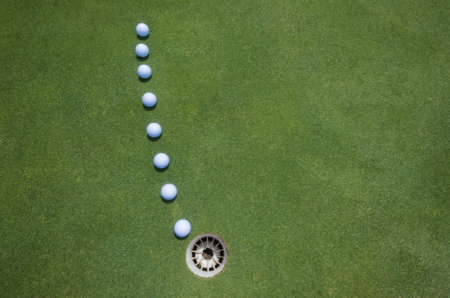
We sat down with our Stephen Sweeney certified putting specialist Ben Clarke to discuss one of the most crucial yet often overlooked skills: How to read a green. Understanding the subtle slopes, undulations, and breaks of the putting surface can significantly impact your success on the golf course. In this week’s blog, we will explore the art of reading greens, providing you with valuable insights and techniques to help you improve your ability to read greens and putts accurately. Whether you’re a beginner or an experienced golfer, mastering green reading can be the key to lowering your scores.
How to Read a Green
Reading greens involves assessing the characteristics of the putting surface to determine the ideal path and speed for your putt. Let’s break down the essential steps for effective green reading:
1. Assess the Overall Putting Terrain
Taking a walk around the green is essential to reading greens. Observe the general layout and contours, look for any obvious slopes, ridges, or valleys. Understanding the big picture will help you make more informed decisions about your putt.
2. Pay Attention to Grass Grain
Grass grain refers to the direction in which the grass on the green grows. It can affect the ball’s roll and the break of your putt. When reading greens, look for clues in the grass, such as lighter or darker patches, which can indicate the direction of the grain. Putts into the grain tend to be slower, while putts with the grain will be faster.
3. Observe Your Surroundings
Take a moment to consider your surroundings. The position of the sun and the presence of any shadows can impact your perception when reading greens. Shadows can exaggerate the slopes, making breaks appear more significant than they actually are. Be aware of these environmental factors when reading the green.
4. Utilize the Plumb-Bob Method
Many golfers use the plumb-bob method to gauge the slope of the green. Hold your putter by the grip and let the head dangle. Align the shaft with your target line and observe how the putter head hangs. If it points to the left, the green slopes left, and if it points to the right, the green slopes right. This method can help you determine the overall break of the putt when reading greens.

Reading the Greens
Now that you’ve learned how to assess the green, let’s dive into the specific elements of how to read a green:
1. Identify the High Point
When reading greens, remember that every putt has a “high point,” a spot on the green where the ball begins to break toward the hole. To find this point, crouch down behind the ball and examine the green from a low angle. The high point is where you should aim your putt to start the ball on the right line.
2. Consider the Speed
The speed of your putt is a critical factor in reading greens. Faster putts typically break less, while slower putts tend to break more. Analyze the distance to the hole and adjust your line accordingly. For longer putts, you may need to aim farther away from the high point to account for the increased break.
3. Visualize the Path
Before taking your putt, visualize the path the ball should take to reach the hole. Pick a specific spot or line on the green to aim for, and commit to it. This mental picture will help you stay focused and execute your putt with confidence.

Learning how to read a green is an essential skill that can significantly improve your golf game. By understanding the terrain, observing grass grain, considering your surroundings, and using methods like the plumb-bob technique, you can accurately read greens. When reading specific putts, focus on identifying the high point, adjusting for speed, and visualizing the ideal path to the hole.
Like any aspect of golf, how to read a green takes practice and patience. Spend time on the putting green refining your skills, and you’ll find yourself sinking more putts and ultimately lowering your scores. By consistently improving your green reading abilities, you’ll gain a competitive edge and enhance your overall golf experience. Happy golfing!
Looking to step up your putting? Book a lesson with our Certified Putting Specialist HERE.
Sign up now for FREE weekly golf tips, content, and much more delivered directly to your inbox. Yup, it's that easy.
Swing Better. Play Better. Leadbetter.